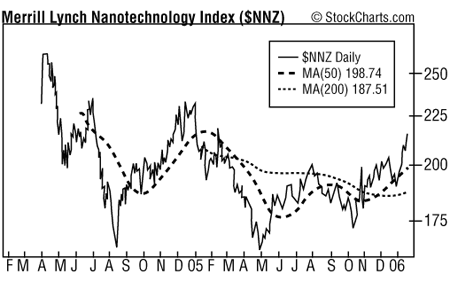
Knowing what you know today, if you had the opportunity to go back in time and invest in the Internet sector in 1997 would you do it? Silly question I know. Even the no-names of the Internet made a fortune for early investors… Companies like Sify Ltd., which shot up over 1,000% in four months. Well… there’s a sector today looks just like the Internet sector did in 1997.
Specifically: It’s not very well understood… Most of the stocks are development-stage companies. And the technology itself has dramatic implications for almost every other industry in the world…
A recent article in Mechanical Engineering states: “This technology may revolutionize production of almost all manmade objects.” And BusinessWeek adds: “[This technology] will unleash unprecedented capabilities. Autos and airplanes, chemicals and plastics, computers and chips, cosmetics and drugs – all of these industries, and plenty more, are facing upheavals that could make the advent of the Internet seem like a minor adjustment.”
In fact, the National Science Foundation predicts that this industry will be worth $1 TRILLION within 5 years – that’s 100 times bigger than the massive biotech industry is today…
And many of the world’s largest companies – across every industry imaginable (from IBM to Nordstrom… Lucent to Samsung… Chevron, Siemens, and Motorola) – are already using this technology in ways we don’t even realize. Still, we’re only at the very, very beginning of this mega-trend. This sector is still in its emerging stage. Consequently… the profit potential is HUGE.
I’m talking about nanotechnology.
Nanotechnology is the science of fabricating things smaller than 100 nanometers (a nanometer is one-billionth of a meter). Basically, we’re changing the construction of products at the cellular level. Think of the BASF advertising slogan, “We don’t make the products you use. We make the products you use better.”
That’s how nanotechnology works…
Nanotechnology doesn’t make the DVD. It makes the DVD scratch resistant. Nanotechnology doesn’t make the fabric. It makes the fabric stain resistant. Nanotechnology doesn’t make the medicine. It makes the medicine easily absorbed by the body. Building at the nanoscale enables new interactions in materials, semiconductors, and biological agents. Ultimately this should also lead to new discoveries in pharmaceuticals, biodefense, and healthcare.
In short, nanotechnology itself is not a separate industry, but rather an applied approach to multiple industries. Consequently, the profit potential for this market is enormous.
However, we’re not there yet. Heck, we’re not even close. Nanotechnology is still in its emerging stage. Most companies have small market capitalizations and very few are even close to turning a profit.
Fortunately, Wall Street cares more about potential than about profit. If you need proof of this fact then just consider the case of Amazon.com (or any other Internet company for that matter). Back in 1999 when Amazon was losing tons of money, Wall Street bid the company up to $110 per share (split adjusted). Today, Amazon actually turns a profit, but the stock changes hands at just about $30 per share.
My point is that when the potential breakthroughs are huge, as was the case with Internet stocks in 1999 or with biotechnology stocks in general, then less attention is paid to profitability. And that’s the situation we find ourselves in with nanotechnology stocks.
This is a growth story – pure and simple. Value investors need not apply.
But it’s not exactly a new story. In fact, when Merrill Lynch first came out with its Nanotechnology Index (^NNZ), back in 2004, the level of hype surrounding nanotechnology shares was at its pinnacle.
Brokerage firms stumbled all over each other as they recommended shares in various nanotechnology companies. CNBC ran multiple segments on the potential benefits of this new technology. And Kudlow & Cramer, a popular CNBC television show, spent two weeks of airtime featuring select nanotechnology companies.
Predictably, those events coincided with the peak in the share prices of most companies in this sector. But for most of the past two years, nanotechnology stocks have trended lower and are only now beginning to show signs of life. Take a look at the chart of the Merrill Lynch Nanotechnology Index (see below).
Notice the peak in the index shortly after its introduction in mid-2004 and the uptrend in 2006.
Consequently, I think now is the time to buy into nanotechnology shares.
By Jeff Clark
Jeff Clark is a frequent contributor to DailyWealth, a free contrarian investment newsletter focused on the safest, most profitable investments in the world. To begin receiving a free subscription – and a free report on the three best gold investments you can make right now – click here.